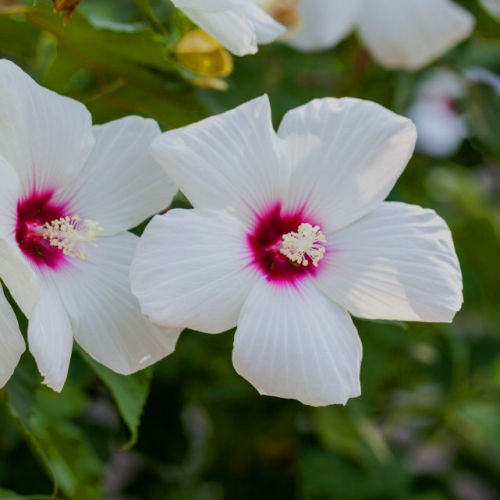Gardening With White Swamp Rose Mallow
White Swamp Rose Mallow is known by its scientific name Hibiscus moscheutos and is celebrated for its spectacular flowers which have a historical significance surpassing their decorative appearance. The Native Americans of North America identified the practical uses of this remarkable plant by utilizing its fibrous stems for weaving and its mucilaginous properties for healing purposes.
European settlers first coming across Hibiscus moscheutos were amazed by how well it survived in marshy areas thanks to its resilience. Botanical records from the 17th century documented the presence of this plant. Hibiscus moscheutos gained recognition as an important formal garden plant especially in the southeastern United States where it thrived under warm and humid conditions.
Botanists documented and cultivated the species through the 19th century and into the early 20th century by developing new hybrids that diversified their color options and increased their environmental adaptability. The plant continues to be cherished by both gardeners and conservationists as it connects past botanical wisdom with today's horticultural methods.
White Swamp Rose Mallow Medicinal Uses and Traditional Applications
For hundreds of years people have recognized Hibiscus moscheutos as a plant with medicinal capabilities. Indigenous peoples prepared herbal treatments for multiple health conditions by using both roots and leaves of this plant. The high mucilage content in this plant rendered it effective for respiratory treatments as well as sore throat and digestive problem remedies.
The leaves and flowers were commonly processed into infusions which acted as anti-inflammatory treatments to alleviate skin irritations and treat burns and minor wounds. Some preparations included root decoctions that helped reduce bladder infections along with other urinary tract pain. Several communities utilized the plant for pain relief by creating poultices that helped reduce swelling and joint pain.
Today's practitioners of herbal medicine and natural healing remain engaged in research on White Swamp Rose Mallow's therapeutic properties. The plant's similarity to medically used Hibiscus species like Hibiscus sabdariffa indicates that new pharmacological properties could be found through further research. Antioxidant-abundant flowers from the plant show potential for incorporation into teas and dietary supplements designed to boost health and wellness.
Discovery and Botanical Documentation
Early European botanists during their exploration of North American marshlands first documented Hibiscus moscheutos. Naturalists recorded this plant's presence in wetland habitats as settlers pushed their boundaries from the eastern United States into the Midwest region.
The plant received a more precise botanical classification through time as taxonomists identified its place within the Malvaceae family. Closely related species' interbreeding capabilities resulted in numerous cultivated varieties that now decorate gardens throughout North America. Wild populations of Hibiscus moscheutos continue to play a crucial role by supporting biodiversity and maintaining wetland health even after humans modified this species for cultivated use.
White Swamp Rose Mallow Landscaping Elegance and Ecological Benefits
White Swamp Rose Mallow gains high value in garden designs because of its magnificent flowers and ability to thrive in diverse conditions. It grows well in rain gardens and boggy spots beside ponds and streams since its deep roots stabilize soil to prevent erosion. This plant attracts home gardeners and restoration practitioners because of its ornamental appeal and ability to sustain local wildlife.

Its standout feature is the abundant summer blooming that produces large, vibrant flowers with hues ranging from soft pink and white to deep red. The large flowers which reach up to ten inches wide serve as an eye-catching centerpiece for any garden. The plant looks fragile yet proves extremely resilient to survive both waterlogged conditions and extended dry spells after establishment.
Hibiscus moscheutos proves to be a perfect selection for gardeners who want to attract pollinators to their landscape. This plant thrives when grown alongside other moisture-loving species like irises and cattails along with native grasses which helps build a diverse and lush garden environment. The Hibiscus moscheutos plant adds visual appeal to gardens and provides essential support for local ecosystems.
The Distinctive Beauty of Hibiscus moscheutos
In wetland regions Hibiscus moscheutos stands out as one of the most visually captivating plant species. This plant develops stems that extend to six feet tall and feature large lobed leaves positioned above its fragile flowers. The flowers display broad petals that overlap with prominent stamens to establish a tropical feel within their temperate home environment.
The plant keeps producing new flowers throughout the growing season so that each day brings fresh blooms to maintain constant color and vibrancy. The petals have a satiny texture with many showcasing a deep central eye that enhances their overall attractiveness. The golden autumn foliage of the plant maintains its decorative appeal throughout the year after the flowering season ends.
White Swamp Rose Mallow Supports Rare Wildlife and Provides Essential Ecological Benefits
Hibiscus moscheutos attracts rare wildlife species due to its essential ecological role beyond its visual beauty. The plant's nectar-filled flowers draw numerous pollinators like hummingbirds, bees, and butterflies thus becoming an essential part of native pollination systems.
This plant functions as the host for various moth and butterfly species such as the hibiscus bee (Ptilothrix bombiformis) which depends entirely on its blossoms to survive. The unique bee species has adapted to harvest pollen solely from hibiscus plants which underscores the important ecological role of this plant.
Hibiscus moscheutos acts as a protective habitat for wetland insects and amphibians which helps sustain the well-being of its natural ecosystem. The vigorous development of this plant forms a safe haven for marshland-dependent creatures while maintaining biodiversity in these delicate ecosystems.
Conclusion
The White Swamp Rose Mallow stands as an emblem of resilience and natural beauty while promoting biodiversity beyond its ornamental value. The amazing perennial plant maintains its appeal to both scientific professionals and nature enthusiasts through its historical importance, medicinal benefits, and conservation impact. Through our efforts to grow and maintain this amazing plant we simultaneously safeguard the habitats and endangered species.